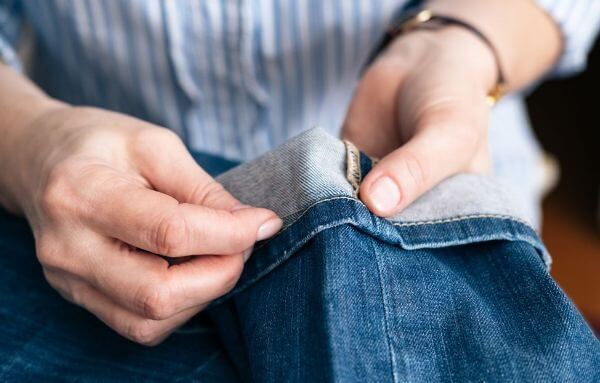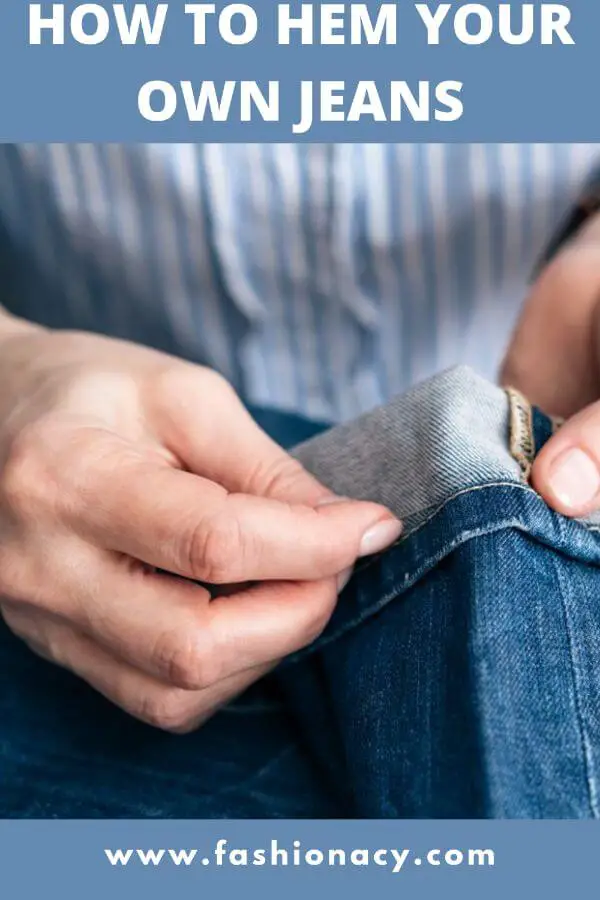
You purchase a brand-new pair of jeans, and while they look great, they are simply too long.
Do you recall the last time a pair of your jeans were too long? Within a few weeks, the hem’s back began to fray.
Don’t allow that to occur once more!
I’m going to explain here how simple it is to hem your jeans. Even a sewing machine won’t be necessary.
What You Need?
You’ll need the following to get going:
- a sewing needle
- thread
- sewing pins
- fabric chalk or pencil
- scissors
- the ruler
- an iron
Find Out The Right Length
Finding the ideal length for your jeans is the first step.
Fold the hem of your jeans till they are the ideal length for you after putting them on while wearing a pair of shoes.
If you complete this step without shoes, your jeans may end up being either too long or too short when worn with shoes.
Anything from a complete break to no break looks excellent with jeans. Decide what suits your style the most.
After placing a pin at the bottom of the fold, remove the jeans.
You must now make a choice. You can hem your jeans using one of two techniques.
The First Method of Hemming Your Jeans
The original hem is kept with the first method, although the fold line will still be visible.
Let’s suppose the hem of the jeans is half an inch.
- I’m going to use my fabric pencil to draw a line that extends half an inch above the pin.
- Go ahead and remove the pin.
- Fold your jeans now so the original hem’s stitched edge is perfectly over the line you just created.
Since you need the side seams to line up precisely, begin by pinning the fabric in place there.
Sewing
It’s time to get sewing now.
A thread that closely resembles the hue of your jeans should be chosen. The stitch should be as undetectable as feasible.
- Cut the thread to three to four feet. For optimal strength, we’ll double thread the needle.
- Before tying a knot, hold the thread through the needle and check that the lengths of both ends are the same.
- Wrap the thread in an X pattern around your index finger to make the knot.
- Pinch the X with your thumb and index finger, then slide your index finger back, allowing the thread to roll forward.
- Before pulling the thread with your other hand, bring your middle finger down in front to hold it.
- As a result, you have a solid knot that won’t unravel.
We will now sew the thread to the pants.
- Pull the needle through after grabbing a few threads from the jeans with the needle. To form a loop, repeat this step a second time, then pull the needle through the loop to form the knot.
- We are now prepared to sew around the entire hem.
- The back stitch will provide the greatest strength, thus we will manually sew it.
- In essence, every stitch will form a whole loop.
- You will therefore use two stitch lengths on one side of the fabric.
- Then push the needle on the opposite side.
- Push the process by looping back one stitch length, pushing it back through to the opposite side of the fabric, and then looping it back up.
- Moving again two stitch lengths forward.
- It can take some time, but it’s better to go slowly so that you have a pair of jeans that won’t fall apart later.
Before you reach the end, you might run out of thread. In that case, relax.
Like you did at the beginning, tie a knot to secure the thread. Rethread your needle and continue after that.
Until you reach the end, keep stitching, then tie a final knot in your thread to secure it.
A quarter-inch to a half-inch seam allowance should be left after trimming the excess fabric with your scissors.
It’s time to make that the edges don’t fray now.
- We’re going to employ a technique known as a whip stitch to accomplish this.
- The whip stitch simply passes through one side of the fabric, looping over the edge to secure it, in contrast to the back stitch, which goes back and forth.
- From one hem end to the other, work your way around. Finish by making a last knot when you reach the end.
- Now that the new seam is flat on both the inside and the outside, press it with your iron for a tidy appearance.
The Second Method of Hemming Your Jeans
You’ll need to sew a new hem for the second technique we’ll employ.
It can be challenging to hand sew a perfectly equal stitch, but there won’t be a fold line like if you preserve the original hem.
Each method so has advantages and disadvantages.
- Turn your jeans inside out, and where you originally pinned them, draw a straight line using the fabric pencil and ruler.
- Next, draw a second line that is one inch beneath the first one.
- Then draw a second line a half-inch above the first.
- Cut off the excess fabric below the bottom line using your scissors.
- Go ahead and remove the pin.
- The bottom edge should be brought to the top line.
- To stop it from fraying, fold it in half.
- This folded edge can be made flat with your iron before being pinned into position.
- Find thread that closely resembles the original gold thread because you’ll be making a new visible hem.
- Form a knot at the end and double thread your needle as previously.
- Pulling the thread through a few other threads and forming a knot will now secure it to the fabric.
- Turn the jeans right side out. So that it appears as clean as possible, you should concentrate on the exterior.
- I prefer to draw a line on the outside of the hem using my fabric pencil and ruler. This aids in helping me maintain somewhat straighter stitches.
- Use the backstitch method to sew the whole length of the hem for optimum strength.
- Work gently, of course. Any errors will be quite obvious because your thread is contrasted.
- Once you’ve reached the end, tie a final knot in your thread to finish it off.
Your jeans are now the ideal length, so there you have it.



